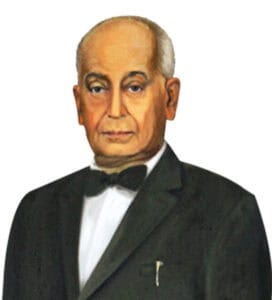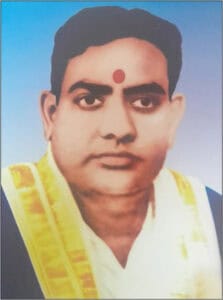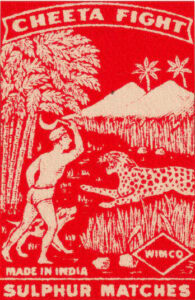In 1900-1910, at least eight match factories existed in India: three in Bombay Presidency, two in Central Provinces, one in Kashmir, and two in Bengal Presidency. A few newer factories came about in different parts of India shortly after. One prominent name in match manufacture in India is the Western-India Match Company (WIMCO) established in Ambernath (Thane district) in 1917 by Svenska Tändsticks AB (Sweden), which commenced industrial-scale, bulk production of matches in 1923. In later years, WIMCO came under the management of ITC Limited, Calcutta. Many Madras residents cannot forget Cheeta Fight matches produced and marketed by WIMCO.
WIMCO established a factory in Tiruvottiyur in the 1920s, which survived until 2010 and the area is known even today as ‘Wimco Nagar’. Cheeta Fight matches are produced today by ITC.
Until 1914, import from Japan met nearly 50 per cent of India’s match needs, whereas that from Sweden met about 30 per cent. With the start of World War I, import of European matches stopped, allowing the Japanese to monopolise the Indian-match market. The Indian-match manufacturers struggled to deal with the Japanese monopoly. It is at this time P(alaniappan) Ayya Nadar (hereafter Ayya) and his older cousin A(rumugam) Shanmuga Nadar (hereafter Shanmugam) kickstarted match and fireworks industry in Sivakasi in the mid-1920s. This was the tiny spark that triggered Sivakasi to grow as a major economic hub of India.

Palaniappan Ayya Nadar. (Courtesy: Dr C. Ashok, Ayya Nadar–Janaki Ammal College, Sivakasi)
Ayya was born to Palaniappan-Nagammal couple in Sivakasi on 17 March 1905. He studied up to school-final class at Sivakasi Hindu Nadar Victoria High School (presently, Sivakasi Hindu Nadar Victoria Higher Secondary School). He died in 1982. Shanmugam was born to Arumugam-Annamalai Ammal couple in Sivakasi on 28 November 1903. He also had studied up to school-final class at Sivakasi Hindu Nadar Victoria High School, Sivakasi. He died in 1963. In the early decades of the 20th Century, Calcutta included small-level match factories operating with semi-mechanical Japanese machines. One P. Chinna Nadar of Sivakasi, a close relative of Ayya and Shanmugam, prompted both them to learn about match production and the commercial potential it had. Led by the conviction that match production would offer a prosperous life, the 17-y old Ayya and 19 y-old Shanmugam arrived in Calcutta in 1922. They joined as workers in a small-level match production unit in Calcutta. They learnt about match sticks and their production. During their work time in Calcutta, they were placed in the packaging section, which deprived them from learning the art of making match sticks. However, they accidentally tumbled on a record book that included details of the chemicals and their quantities required for making matches. From this book, both Ayya and Shanmugam learnt about the composition of the burnable material used in matchsticks. They are supposed to have ‘trained’ with one Purna Chandra Ray, a chemical engineer–entrepreneur in Calcutta and who had previously trained in match production in Germany.

Arumugam Shanmuga Nadar. (Courtesy: Dr Rengaiah Murugan, Madras Institute of Development Studies, Chennai)
After eight months of stay in Calcutta, Ayya and Shanmugam returned to Sivakasi. Shortly after they jointly established the first match-production unit under the banner ‘South-India Lucifer Match Industry’ (SILMI) in Sivakasi in 1923. They imported a machine from Germany to automate the process. Ayya and Shanmugam soon realised that mechanised production required high-quality wood material – a dear commodity at that time. Influenced by Mohandas K. Gandhi’s call encouraging the development of cottage industries in the 1920s, both Ayya and Shanmugam shifted to labour-intensive, non-mechanised production of matches after 18 months of their return from Calcutta. They recognised the strengths of re-developing their production unit as a cottage-industry unit rather than a mechanised industry, because of the easy availability of human power in Sivakasi and its neighbourhood. They attempted producing colour matches, because the processes of making non-colour and colour matches were not far different in terms of either materials or cost. Ayya established the ‘anil’ brand and Shanmugam established the ‘crow’ brand match-production units. These efforts laid the first brick in the foundation for Sivakasi’s growth. SILMI produced the less-safe sulphur matches from 1923, and ‘safety’ matches in 1932.
The similarity in processes in matchstick and firecracker manufacture prompted Ayya and Shanmugam to travel again to Calcutta in 1930 to learn about firecracker production. The first firecracker unit, developed as a cottage industry came into existence in Sivakasi, which enabled cost-efficient production of firecrackers in India. The Government of India regulated the import of raw materials needed for the production of explosives, a little earlier and during World War II, which facilitated the economic growth of Sivakasi.
Easy access to the wood of choice from the neighbouring princely state of Travancore (presently southern Kerala) provided an ideal environment for match-stick production in Sivakasi. Geographically Sivakasi (7 km2) is a near-flat inland town with Tuticorin (presently Thoothukudi) as its nearest sea port (c. 100 km; today Thoothukudi includes an airport). Sivakasi’s consistent hot and dry weather through the year, day temperature between 25 and 40°C, scant rainfall (80 cm/y), and an average RH of 75% were ideally suitable for match and firecracker industries. Another key advantage was the easy availability of ‘cheap’ human labour. The yearly production of fire crackers is around 50,000t and the industry monetary value turnover is approximated around Rs. 6,000 crores.
The technical and commercial know-how developed by Ayya and Shanmugam in Sivakasi enthused many local residents to take to match production, which further encouraged nearly all of them to indulge in firecracker-production as well, developing their firecracker units as ancillary divisions of matchstick production units. Until 1930, the colourful labels pasted on match boxes and firecracker packs came from Bombay. An enterprising K. S. A. Arunagiri Nadar (1899–1961) established the first printing unit — the National Lithographic Press — in Sivakasi, initiating high-quality lithography. One other memorable name in Sivakasi’s print sector was S. Kaliappa Nadar, who established the Sivakasi Industrial Printing Works in 1937, paving the way for the colour-offset printing. The NLP and SIPW together changed the overall complexion of offset printing in India — a highly developed and diverse industry today that meets the needs of production of spectacular calendars, multi-colour brochures and product flyers, and even high-security products such as stationery used in banking and other financial industries, not only fully catering to needs of India and but in other Asian countries as well. The printing units founded by N. R. K. Rajarathna Nadar and Arunagiri Nadar are to be remembered with gratitude at this point. Today Sivakasi boasts of about 450 offset and flexographic printeries. More than 50,000 workers are employed in printing industries alone in Sivakasi. The Sivakasi Institute of Printing Technology (established in 1977) by the Sivakasi Master Printers’ Association (established in 1948) trains people in modern printing technology. The printing industry in Sivakasi alone is Rs. 10,000 million/y worth, which responds to more than 60 per cent India’s colour-offset printing needs.
With India’s Independence in 1947, the matchbox and firecracker industry in Sivakasi and neighbouring dry districts of the present Tamil Nadu have grown substantially. However, the Sivakasi match industry went through a rough economic patch in the mid-1960s because of an intense scarcity of raw materials, particularly red phosphorus, further complicated by recession and economic crisis in India in the 1960s, resulting in unemployment. Rajnikant Devidas Shroff of the United Phosphorus Limited (presently UniPhos), Bandra, Bombay, established a warehouse to store and distribute red phosphorus in Sivakasi in 1971. Rajnikant Shroff’s action went a long way in solving the paucity of red phosphorus in this region and facilitated it to bounce back. Close to 3,500 production units producing matches are fully operational today in Sivakasi and neighbourhood. Nearly 30,000 persons are directly employed. The market for safety matches is presently prosperous, growing at the rate of 10%/y.
Sivakasi has propelled itself to remain a self-reliant, industrial town producing large quantities of fireworks and matches; offset and lithographic printing is flourishing adding another layer of shine. Sivakasi contributes to nearly 90% of the total production of firecrackers in India and is a major supplier to the rest of the world: for that matter, it — a small town in interior Tamil Nadu — competes aggressively with China — the premier producer of firecrackers. Sivakasi contributes about 70% of the safety matches in India, fetching a gross revenue of c. Rs 30,000 m/a. As a single town, Sivakasi provides the greatest revenue to the state of Tamil Nadu and Government of India, further to ensuring nearly 100% employment. It is claimed that the first Prime Minister of India, Jawaharlal Nehru, referred to Sivakasi as ‘mini-Japan’ for the enterprise and enthusiasm it demonstrated in economic growth in the 1960s.

It’s a wonderful historical review on Match and fireworks industries in South India. The contributions of Ayya and Shanmugam are well brought and recognised.
Indeed it is mini Japan! I used to wonder how this remote place became so well recognised. The people are innovative and Nadar community, forward looking in business.
Love the informative story.
K R A Narasiah
The article gives information.at length about Sivakashi Match industry , Fire works industry and Printing industry and Institute of Printing Technology . I like this article . I would like to write a short story about shivakashi to encourage cottage industry every where ,Asian interested to see india blossom in.self reliance and employment generation